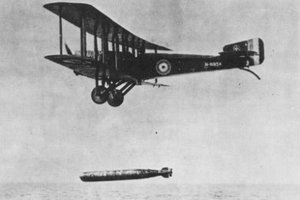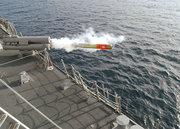Torpedo
|
|
A modern torpedo, historically called a self-propelled torpedo, is a self-propelled guided projectile that (after being launched above or below the water surface) operates underwater and is designed to detonate on contact or in proximity to a target. Torpedoes are weapons that may be launched from submarines, surface ships, helicopters and fixed-wing aircraft, and from unmanned naval mines.
They are also used as parts of other weapons; the Mark 46 torpedo used by the United States becomes the warhead section of the ASROC (Anti-Submarine ROCket) and the Captor mine uses a submerged sensor platform that releases a torpedo when a hostile contact is detected.
| Contents |
Etymology
Torpedo.Plymouth.NavyAndArmyIllustrated.jpg.jpg
The word torpedo comes from the Torpedo genus of electric rays in the order Torpediniformes, which in turn comes from the Latin "torpere", to be stiffened or paralyzed. There is no physical resemblance between the ray and the mechanical torpedo.
In naval usage, the term "torpedo" was first used by Robert Fulton who used the word for the towed gunpowder charge used by his submarine Nautilus in 1800–1805 to demonstrate that it could sink warships.
The term became generally used to refer to tethered naval mines, developed in the American Civil War in the 1860s by Matthew F. Maury, a Confederate Admiral (these are what David Farragut was referring to when he ordered his men to "damn the torpedoes, full speed ahead"). This use of the word to refer to what are now called "mines" lasted until World War I. As self-propelled torpedoes were developed the tethered variety was referred to as "stationary torpedo" and later "mine".
History

The first torpedoes driven at the target were spar torpedoes – the explosive device was on the end of a spar up to 40 feet long projecting forward under the water from the attacking vessel. When driven up against the enemy and detonated a hole would be caused below the water line. These devices were used in the American Civil War.
Attempts had been made to develop unpowered but directable towed torpedoes, such as the torpedo created by John and Frederick Harvey. Matthew F. Maury worked on an electric torpedo design during the American Civil War, but the result wasn't an effective weapon.
The first prototypes of a self-propelled torpedo were created by Ivan Lupis-Vukić, a retired Croatian naval engineer who served in the Austro-Hungarian Navy. The design was presented to the Emperor Franz Joseph in the port city of Rijeka in 1860. Robert Whitehead, an English engineer/entrepreneur, was working in the Trieste port on navy projects, so in 1864 Lupis made a contract with him in order to perfect the invention. This resulted in Minenschiff, the first self-propelling torpedo, officially presented to the Imperial Naval commission on December 21, 1866.
Torpedo_narrow_miss.jpg
After the government decided to invest in the invention, Whitehead started the first torpedo factory in Rijeka. In 1870, they improved the devices to travel up to 1,000 yards (914 m) at a speed of up to six knots, and by 1881 the factory was exporting its torpedoes to ten other countries. The torpedo was powered by compressed air and had an explosive charge of gloxyline or gun-cotton. Whitehead went on to develop more efficient devices, demonstrating torpedoes capable of 18 knots (1876), 24 knots (1886) and finally 30 knots (1890).
Whitehead purchased rights to the gyroscope in 1890 to improve self-regulation of his designs. Whitehead's torpedoes came to be called the Devil's device.
In 1877 the British Admiralty paid him £15,000 for certain of his developments and he opened a new factory near Portland harbour in 1891. The largest Whitehead torpedo was 19 feet (5.8 m) long, 18 inches (457 mm) in diameter made of polished steel or phosphor-bronze, the explosive charge was up to 200 lb (90 kg) of gun-cotton. The air was compressed to around 1,300 lb/in² (approx 90 times atmospheric pressure) and drove two propellers through a three cylinder Brotherhood engine. Considerable effort was taken in trying to ensure that the torpedo self-regulated its course and depth.
Battleship_torpedo_net.jpg
Blanco Encalada was the first ship sunk in a military action by a self-propelled torpedo from the torpedo gunboat Lynch, during the Chilean civil war on April 23 1891. During this time, the torpedo boat invented by John Ericsson gained recognition for its efficiency, and the first torpedo boat destroyers were built to counter it.
Around 1897, Nikola Tesla patented a remote controlled boat and later demonstrated the feasibility of radio-guided torpedoes to the United States military. Radio remote controlled torpedoes remained uninvestigated until the 1960s.
During World War I, torpedoes came to mean self-propelled projectiles fired from a ship or submarine. Later, torpedoes were given (homing) guidance systems.
The compressed air system was improved by the addition of the heater, petrol sprayed into the expansion chamber and ignited increased the volume of gas and so more power and range was developed.
All classes of ship from destroyers to battleships were armed with torpedoes.
Torpedo classes and diameters
Torpedoes are most commonly launched in one of four ways:
- From the deck-mounted torpedo launcher of a vessel on the surface.
- From a torpedo tube mounted either below the waterline of a vessel on the surface, or on a submarine.
- From a low-flying aircraft or helicopter.
- As the final stage of a compound rocket or ramjet powered munition (sometimes called an assisted torpedo).
Many navies have two weights of torpedoes:
- A light torpedo used primarily as a close attack weapon, particularly by aircraft.
- A heavy torpedo used primarily as a standoff weapon, particularly by submerged submarines.
In the case of deck or tube launched torpedoes, the diameter of the torpedo is obviously a key factor in determining the suitability of a particular torpedo to a tube or launcher, similar to the calibre of the gun. The size is not quite as critical as for a gun barrel, but diameter has become the most common way of classifying torpedoes.
Mark_48_Torpedo_testing.jpg
Length, weight, and other factors also contribute to compatibility. In the case of aircraft launched torpedoes, the key factors are weight, provision of suitable attachment points, and launch speed. Assisted torpedoes are the most recent development in torpedo design, and are normally engineered as an integrated package. Versions for aircraft and assisted launching have sometimes been based on deck or tube launched versions, and there has been at least one case of a submarine torpedo tube being designed to fire an aircraft torpedo.
As in all munition design, there is a compromise between standardisation, which simplifies manufacture and logistics, and specialisation, which may make the weapon significantly more effective. Small improvements in either logistics or effectiveness can translate into enormous operational advantages.
Some common torpedo diameters (using the most common designation, metric or inch, and listed in increasing order of size):
- 12.75 inch (approximately 324mm) is the most common size for light torpedoes.
- 16 inch (406mm) was the size of the earliest specialised Soviet ASW torpedoes. 16 inch torpedo tubes were fitted to Soviet Hotel, Echo and early Delta class submarines, often in addition to 21 inch tubes.
- 17.7 inch (450mm) was the standard size for light torpedoes of the Imperial Japanese Navy. This size is sometimes referred to as 18 inches.
- 21 inch (533mm) is the most common size for heavy torpedoes, including:
- Allied torpedoes of the Second World War.
- Some torpedoes of the Imperial Japanese Navy.
- NATO torpedoes.
- Some Soviet and Russian torpedoes, including the current ASW models.
- 24 inch (610mm) torpedoes were used by the Imperial Japanese Navy, most famously the deck launched Type 93 torpedo, also some Kaitens.
- 650mm (approximately 25.6 inches) is the largest torpedo diameter used by the Russian navy, see Type 65 torpedo. Adaptors are used to fire 533mm (21 inch) munitions from 650mm tubes.
Even larger sizes of torpedo tube, including 660mm (26 inches), 30 inch (about 762mm) and 36 inch (about 914mm), have been installed on some nuclear submarines. These tubes are designed to be capable of firing large diameter munitions such as cruise missiles, as well as the standard 21 inch heavy torpedo. See torpedo tube.
Torpedoes used by the US navy
The four major torpedoes in the United States Navy inventory are:
- the Mark 48 heavyweight torpedo,
- the Mark 46 lightweight and
- the Mark 50 advanced lightweight.
- the Mark 54 torpedo.
Torpedoes used by the UK navy
The torpedoes used by the Royal Navy include:
Torpedoes used by the Japanese navy
The torpedoes used by the Imperial Japanese Navy included:
- Type 91 torpedo
- Type 92 torpedo
- Type 93 torpedo ("Long Lance")
- Type 95 torpedo
- Type 97 torpedo
- Kaiten
Torpedoes used by the Russian navy
Torpedoes used by the Russian Navy include:
See also
External links
- US Navy torpedo data cut and pasted from a Navy Fact File (http://www.chinfo.navy.mil/navpalib/factfile/weapons/wep-torp.html)
- A slightly more recent writeup on the Mk-48 is available at a SSBN 624 web site by Clwyd (http://www.welshcoast.net/clwyd/ssbn624/torpedo.htm)
- Early History of the Torpedo Torpedo History (http://www.btinternet.com/~philipr/torps.htm)de:Torpedo
es:Torpedo fr:Torpille he:טורפדו nl:Torpedo ja:魚雷 no:Torpedo pl:Torpeda pt:Torpedo sv:Torped

